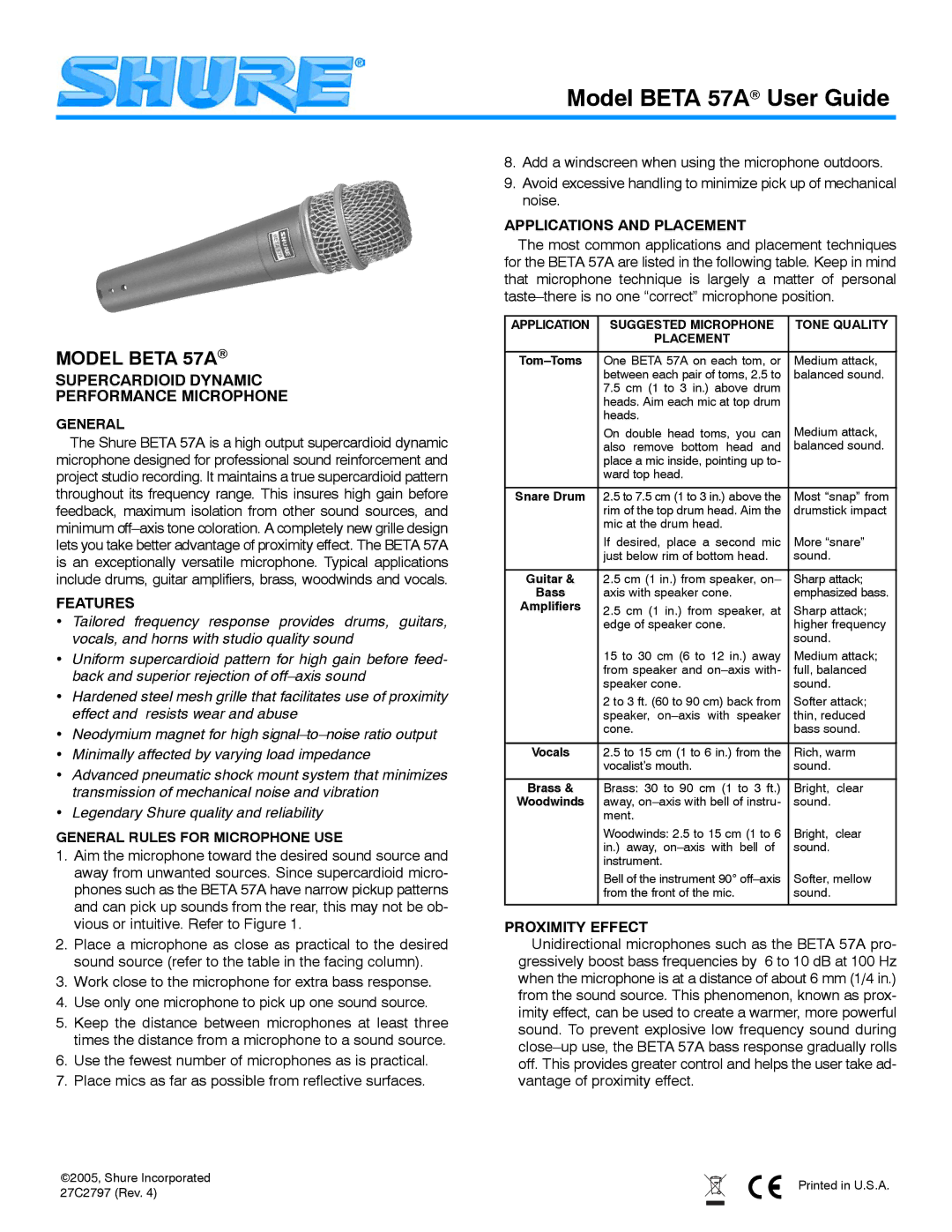
Model BETA 57A User Guide
MODEL BETA 57A
SUPERCARDIOID DYNAMIC
PERFORMANCE MICROPHONE
GENERAL
The Shure BETA 57A is a high output supercardioid dynamic microphone designed for professional sound reinforcement and project studio recording. It maintains a true supercardioid pattern throughout its frequency range. This insures high gain before feedback, maximum isolation from other sound sources, and minimum
FEATURES
•Tailored frequency response provides drums, guitars, vocals, and horns with studio quality sound
•Uniform supercardioid pattern for high gain before feed- back and superior rejection of
•Hardened steel mesh grille that facilitates use of proximity effect and resists wear and abuse
•Neodymium magnet for high
•Minimally affected by varying load impedance
•Advanced pneumatic shock mount system that minimizes transmission of mechanical noise and vibration
•Legendary Shure quality and reliability
GENERAL RULES FOR MICROPHONE USE
1.Aim the microphone toward the desired sound source and away from unwanted sources. Since supercardioid micro- phones such as the BETA 57A have narrow pickup patterns and can pick up sounds from the rear, this may not be ob- vious or intuitive. Refer to Figure 1.
2.Place a microphone as close as practical to the desired sound source (refer to the table in the facing column).
3.Work close to the microphone for extra bass response.
4.Use only one microphone to pick up one sound source.
5.Keep the distance between microphones at least three times the distance from a microphone to a sound source.
6.Use the fewest number of microphones as is practical.
7.Place mics as far as possible from reflective surfaces.
8.Add a windscreen when using the microphone outdoors.
9.Avoid excessive handling to minimize pick up of mechanical noise.
APPLICATIONS AND PLACEMENT
The most common applications and placement techniques for the BETA 57A are listed in the following table. Keep in mind that microphone technique is largely a matter of personal
APPLICATION | SUGGESTED MICROPHONE | TONE QUALITY | |
| PLACEMENT |
|
|
|
|
| |
One BETA 57A on each tom, or | Medium attack, | ||
| between each pair of toms, 2.5 to | balanced sound. | |
| 7.5 cm (1 to 3 in.) above drum |
|
|
| heads. Aim each mic at top drum |
|
|
| heads. |
|
|
| On double head toms, you can | Medium attack, | |
| also remove bottom head and | balanced sound. | |
| place a mic inside, pointing up to- |
|
|
| ward top head. |
|
|
|
|
| |
Snare Drum | 2.5 to 7.5 cm (1 to 3 in.) above the | Most “snap” from | |
| rim of the top drum head. Aim the | drumstick impact | |
| mic at the drum head. |
|
|
| If desired, place a second mic | More “snare” | |
| just below rim of bottom head. | sound. |
|
|
|
| |
Guitar & | 2.5 cm (1 in.) from speaker, on– | Sharp attack; | |
Bass | axis with speaker cone. | emphasized bass. | |
Amplifiers | 2.5 cm (1 in.) from speaker, at | Sharp attack; | |
| |||
| edge of speaker cone. | higher frequency | |
|
| sound. |
|
| 15 to 30 cm (6 to 12 in.) away | Medium attack; | |
| from speaker and | full, balanced | |
| speaker cone. | sound. |
|
| 2 to 3 ft. (60 to 90 cm) back from | Softer attack; | |
| speaker, | thin, reduced | |
| cone. | bass sound. | |
|
|
| |
Vocals | 2.5 to 15 cm (1 to 6 in.) from the | Rich, warm | |
| vocalist’s mouth. | sound. |
|
|
|
|
|
Brass & | Brass: 30 to 90 cm (1 to 3 ft.) | Bright, | clear |
Woodwinds | away, | sound. |
|
| ment. |
|
|
| Woodwinds: 2.5 to 15 cm (1 to 6 | Bright, | clear |
| in.) away, | sound. |
|
| instrument. |
|
|
| Bell of the instrument 90° | Softer, mellow | |
| from the front of the mic. | sound. |
|
|
|
|
|
PROXIMITY EFFECT
Unidirectional microphones such as the BETA 57A pro- gressively boost bass frequencies by 6 to 10 dB at 100 Hz when the microphone is at a distance of about 6 mm (1/4 in.) from the sound source. This phenomenon, known as prox- imity effect, can be used to create a warmer, more powerful sound. To prevent explosive low frequency sound during
2005, Shure Incorporated |
| Printed in U.S.A. |
27C2797 (Rev. 4) |
| |
|
|
